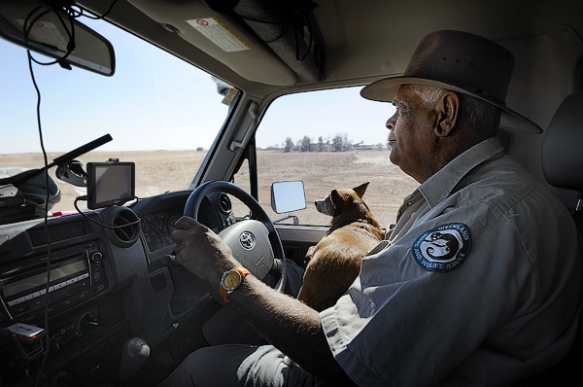This short ABC news report – Twin celebrations for Wangkangurru Yarluyandi people, features Elders talking of their Native Title Claim success. I take my hat off to them for this success story; the years of hard work and the suffering that has gone into achieving this moment. Don Rowlands and Jim Crombie, who feature in the report, both helped develop the Grounded exhibition and I am so delighted to see them here relating the good news. Having had the honour of spending time with them, I know how much heart and soul has gone into getting to this point.
For those new to the blog, the Grounded exhibition, a commission by Glasgow Life for Festival 2014 XX Commonwealth Games, is now open at An Lanntair Art Gallery in Stornoway, Isle of Lewis, from 13 September to 11 October, a partner event at Hebtember Festival.
The Grounded residency diary entries and photographs begin here in Scotland and then in Australia here. The book that accompanied the exhibition can be found at Exhibition explanatory book
You can also link to information about the exhibition at these links: Introductory panel in English and Introductory panel in Gaelic.
Three audiovisuals that were part of Grounded, and the promotional audiovisual, can be watched here
Educational workshops run at An Lanntair Gallery in conjunction with Grounded can be viewed here and here.
Joe’s educational video of me talking about the exhibition can be viewed here.
The introductory page for the blog can be found here. Feedback on the Glasgow Festival 2014, XX Commonwealth Games exhibition can be linked to here. Photos of the Glasgow opening event are here. Glasgow workshops, talks and exhibition details are here. And the Digital Resources pages of the blog for further information are here and here.
An interview about my work with journalist Jim Gilchrist is on the Struileag website which can be linked to here. And a response to the Alice Springs jail post by Professor Smith can be found here. A BBC Radio Scotland interview can be found here. A review by Dr Kate Robinson can be found here. And you can listen to a cut down recording of “In Conversation: Connecting through Culture” at this Vimeo link. (16 mins.) (One of our afternoon events at Glasgow Festival 2014 showing). Or listen to some music from one of our Glasgow afternoon events here.
My artist biography can be linked to here and here and my personal website is here
Some other sites that link to Grounded can be found here
Funder acknowledgements can be viewed here





